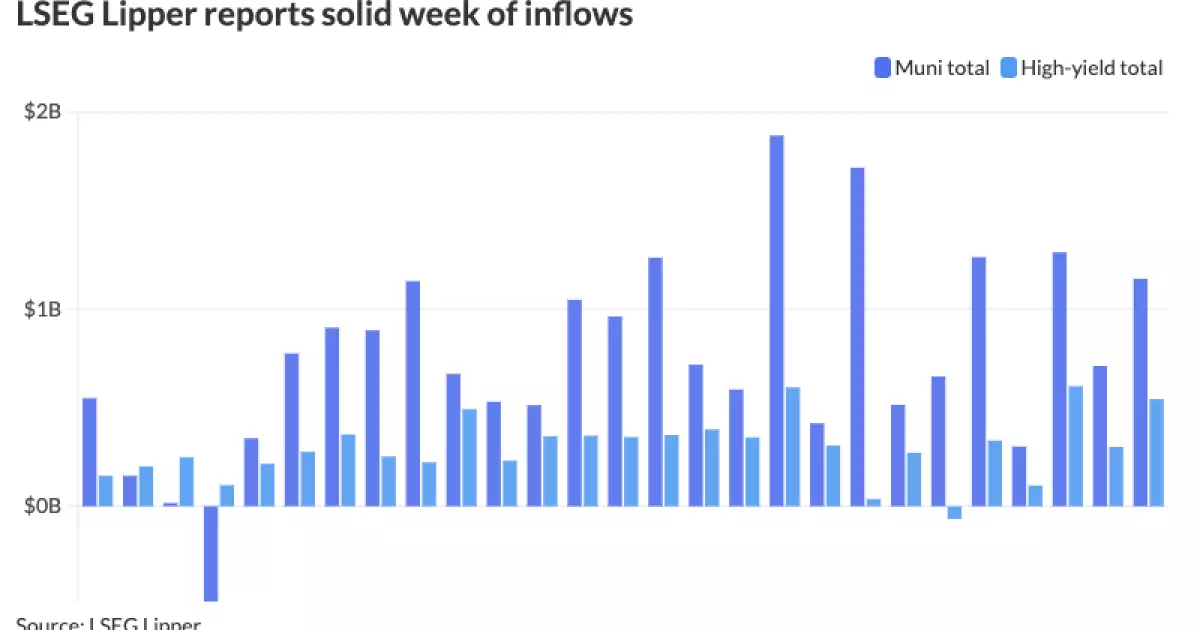The municipal bond market is presently experiencing a series of dynamic shifts influenced by both ongoing trading activity and broader economic conditions. While secondary trading in municipal bonds has shown limited movement, the primary market has been bustling with significant deals, reflecting a shift in investor focus. Additionally, municipal bond mutual funds have registered notable inflows, exceeding the $1 billion mark, indicating sustained interest from investors.
According to reports from Lipper, municipal bond mutual funds enjoyed inflows of approximately $1.154 billion during the week ending December 4, a significant increase from the prior week’s revised figure of $711.5 million. This rising trend in high-yield municipal bond funds is particularly striking, as they attracted $534.1 million, marking an increase from the previous week’s $300.6 million in inflows. Chris Brigati, senior vice president and director of strategic planning and fixed income research at SWBC, conveyed optimism about the continued demand from investors, stating that they are not yet fatigued by the investment landscape. This perspective underlines a broader sentiment within the market that may lead to a more robust environment for municipal bonds.
Diving deeper into the metrics of municipal bond trading, Refinitiv Municipal Market Data recorded several key ratios that investors closely monitor. As of Thursday, the two-year municipal to U.S. Treasury (UST) ratio stood at 61%, with the five-year at 63%, the ten-year at 65%, and the thirty-year at 82%. ICE Data Services presented slightly higher figures, showing the two-year at 62% and the thirty-year at 81%. These ratios indicate a relative value assessment that can guide investor strategies, reflecting the competitive edge of municipal bonds against Treasuries.
Historically, December has been a significant month for municipal bonds, with average issuance reaching approximately $31 billion since 2013. However, this year’s expected issuance could trend toward $500 billion, a reflection of increased demand against a backdrop of potential policy changes. Matt Fabian, a partner at Municipal Market Analytics, highlighted concerns regarding future tax exemptions for municipal issuers. If Republicans were to restrict access to tax exemptions next year, issuers may rush to release more bonds in December. This situation presents a potential risk for investors and could disrupt the typical seasonal behavior of the market.
The stakes are high when it comes to the preservation of tax exemptions on municipal funds. Matthew Norton, chief investment officer of municipal bonds at AllianceBernstein, along with portfolio manager Daryl Clements, emphasized that compromise across party lines is necessary to maintain the status quo concerning tax exemptions. The implications of altering or abolishing these exemptions could be detrimental, not only threatening economic growth but also curbing essential infrastructure investments throughout the country. They argue that maintaining the exemption is crucial, considering it only contributes a modest $40 billion in annual savings to the federal budget amid a $6.5 trillion total budget.
Despite concerns surrounding tax implications, the primary market has been lively, exemplified by a series of substantial deals recently finalized. Barclays, for example, priced $1.5 billion in transportation bonds for the New Jersey Transportation Trust Fund Authority, demonstrating the state’s commitment to infrastructure improvements. Similarly, J.P. Morgan Securities managed $772.65 million in airport facilities revenue bonds for the Greater Orlando Aviation Authority, illustrating the growing recognition of financing needs within the transportation sector.
Additionally, RBC Capital Markets’ pricing of $653.63 million in sales tax securitization refunding bonds signifies strong activity in states aiming to secure refinancing options. Other firms, including BofA Securities and Wells Fargo, have also engaged in various significant offerings, suggesting a resilient demand for municipal securities despite the overarching uncertainties.
The municipal bond market currently reflects a combination of steady trading conditions and potential volatility induced by legislative considerations. With mutual fund inflows remaining robust and primary market activity picking up, investors appear to be navigating a complex landscape. Balancing optimism against the backdrop of tax policy uncertainties will be pivotal in determining the future trajectory of municipal bonds. The coming weeks will be critical as market participants assess both the immediate opportunities and the potential for longer-term disruptions.


Leave a Reply